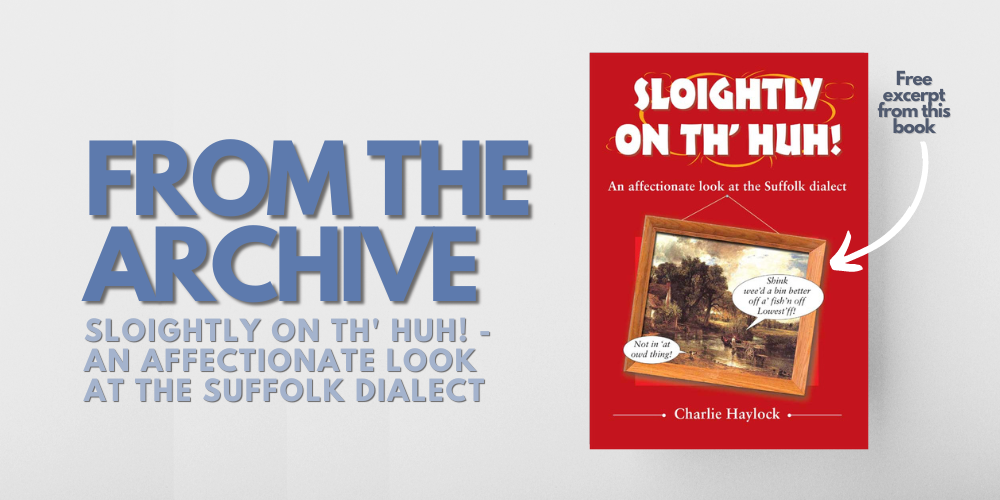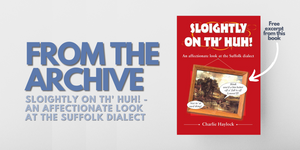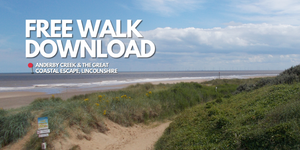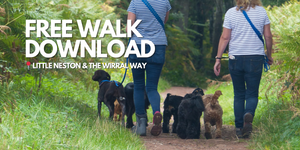FREE Chapter from Sloightly on th' Huh! - An Affectionate Look at The Suffolk Dialect

Chapter 2: Suffolk Place-names
The names of villages and towns in Suffolk demonstrate the cosmopolitan nature of its history, although the vast majority are nevertheless Anglo-Saxon in origin.
As in the other areas of England that came under Anglo-Saxon control, many Suffolk place-names are actually made up of the personal name of a local Anglo- Saxon chieftain or leader, plus the type of settlement added at the end. Places ending in ton (tun) usually means a 'farmstead' or 'enclosure' (e.g. Stuston, in which the personal name is Stūt): ham (hām) 'homestead'. 'hamlet' or 'manor' (e.g. Saxmundham, formed with the personal name Seaxmund): field (feld) is 'open land' (e.g. Sternfield, with Sterne), or leigh or ley (leah) 'woodland clearing' (e.g. Eleigh, with Illa; Gazeley, from Gægi: Hemley from Helma; and Otley, with the personal name Otta). While ing in the middle or at the end of a place-name usually means the 'family' or 'people', belonging to the chieftain (e.g. Cretingham, Framlingham and Nedging Tye). Many small hamlets and villages in Suffolk end with the suffix tye. This is a dialect word denoting a large common pasture and is more or less confined to Suffolk, where it is quite common (e.g. Bower House Tye, Cornard Tye, Dorking Tye, Honey Tye. Kersey Tye. Stoke Tye. to name but a few); only a very few examples are found outside the county.
Place names ending in -ey, -ay, or –eye tend to denote land surrounded by water, or a dry area of higher land in a marsh or bog. Again, this element is sometimes associated with a personal name. (e.g. Bungay and Lindsey). However, Eye has no chief's name at all. Could it be that Eye was a commune or common land, and became the first village to be in the 'public eye’?! I think not … just an island in the middle of extensive marshland. The prefix Kers in Kersey, either refers to an assembly place (assembly island) or watercress (cress island) – the experts do not yet see 'ey' to 'ey'. Nayland is a shortened version of 'atten-ay-land'.
Bury St Edmunds is so called, because it was an Anglo-Saxon burh 'fort'. 'stronghold'. The dedication is to Edmund, a 9th century king of East Anglia, who was canonized, according to legend, because he would not share his Christian kingdom with invading Danes, who then promptly tied him to a tree and filled him with arrows. The diocese is known as St Edmundsbury, and this technically would be more correct.

Ipswich, is an Anglo-Saxon wic 'port' or 'trading place' associated with a man called Gip, and recorded in Domesday Book (1086) as Gipeswic. The Angle and Saxon variants in pronunciation are uniquely preserved in Ipswich (the softened g of the Angles, pronounced y - Yipeswic, having eventually become lost), while the Saxon hard g is retained in names such as Gippeswick and the River Gipping.
There are, of course, many other Anglo-Saxon place-names, too numerous to list, but some odd ones are worth mentioning. Ashbocking ('place at the ash trees' belonging to the Bocking family, Culpho (Cuthwulf's ridge). Herringfleet ('creek or stream of the family or followers of Herela'). Knodishall-cum-Buxloe (Cnott's shelter or nook of land near a deer's burial ground). Orford (possibly 'the ford near the shore': the river name. Ore, is formed from the place name a so-called back formation), Pettistree ('Peohtred's tree'). Rickinghall. Inferior and Superior ('nook of the family or followers of Rica' and a unique Suffolk way of saying Great and Little Rickinghall). Southwold ('south forest). Witnesham (Wittin's homestead"). Sutton Hoo ('southern farmstead on a ridge') and Wetheringsett- cum-Brockford ('the settlers of Weder's tribe by a ford').
Such place-names demonstrate how important the Anglo-Saxons were in building the foundations of modern Suffolk, its people, speech, humour, etc. From here, the further west or north one travels, the more this influence diminishes until at the extreme margins, where the Celtic population remained or sought refuge, it virtually disappears, and this is reflected in the place-names. Look at the place-names of Cornwall, for example, and you will see very quickly that the -hams. -leys and -ings disappear completely, and only one -ton has survived: Launceston.
Added to Suffolk's Anglo-Saxon heritage, is a richness of other cultures, evidence of which is once again testified by the place-names. Earlier settlers, the Celts (the Iceni) and pre-Celts, are remembered in various place-names and river names in the county, such as Iken. Curiously, though, the Romans, although they stayed in the country for close on 400 years, left not one enduring Latin place- name. However, their mark on the physical landscape is often recorded in Anglo- Saxon place-names. Old English burg, for example, frequently refers to Roman fortifications (Burgh and Burstall had Roman forts, as did Grundisburgh), while Old English stræt specifically denoted a paved and therefore Roman road, and place-names like Stradbroke. Stradishall, Stratford St Andrew and Stratford St Mary came into existence.
After settlement by the Anglo-Saxons, incursions and eventual settlement by successive waves of Norse invaders were to leave their mark on the stock of Suffolk place-names. For example, the Old Scandinavian word by 'farmstead' appears in names like Barnby and Risby ('the farmstead of B(j)arni', 'the farmstead among the brushwood (Old Scandinavian hris), respectively). More interestingly, perhaps, the two cultures come together in names like Flixton. Thrandeston, and Uggeshall - each formed with an Old Scandinavian personal name (Flik. Thrándr, and Uggeca, respectively) combined with an Old English topographic suffix (tün 'farmstead', 'settlement' or halh 'nook of land'). Such blends can sometimes be puzzling: the Old Scandinavian word for street, gata is confusingly similar to Old English geat 'gap'. 'gate'. 'pass', and sometimes only close scrutiny of the topography of the place in question can settle which word is the more likely component of its name.
Finally, the Normans, too, left their mark, with names like Boulge (‘heathland’). Capel ('chapel') St Andrew, and Capel St Mary - just another ingredient in the rich recipe that is Suffolk place-names.
The ingredients for Suffolk, may be the same in a few other places, but quantities would be different, hence the marked regional differences. Suffolk could be: -
5lb Angles
4lb Saxons
2lb Normans
1 pint Danes
2 tablespoons Jutes
2 tablespoons Fresians
3 teaspoons Viking
1 teaspoon Celt
2 Romans beaten and whisked (vigorously)
Pinch of Dutch
Put all ingredients together, stir thoroughly for a rich mixture, and you end up with the Suffolk people, its dialect, its humour, in fact, its whole make up. Alter the quantities or leave some out, and the mixture will turn out very differently: so will the make-up of the people, including the dialect, and the place-names.
This chapter is taken from Sloightly on th' Huh! - An Affectionate Look at The Suffolk Dialect
- Rory Batho







Comments 0